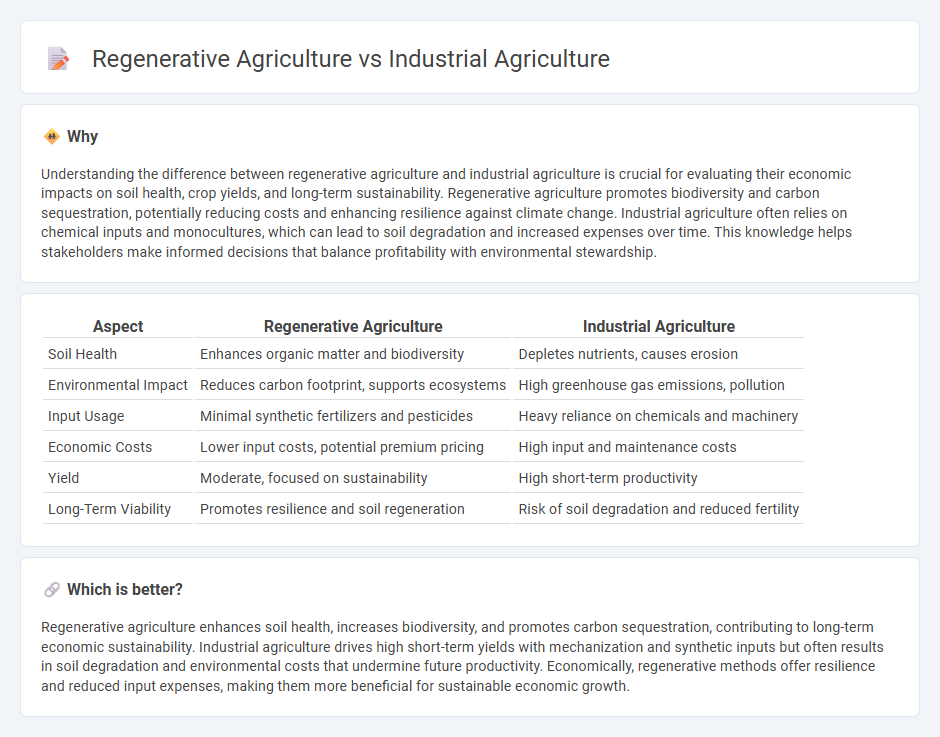
Regenerative agriculture prioritizes soil health, biodiversity, and carbon sequestration to create sustainable food systems, contrasting sharply with industrial agriculture's focus on high yields through monocultures, synthetic inputs, and mechanization. This shift influences economic outcomes by reducing input costs, enhancing ecosystem services, and opening new markets for eco-conscious consumers. Discover how this transition impacts global economies and investment opportunities.
Why it is important
Understanding the difference between regenerative agriculture and industrial agriculture is crucial for evaluating their economic impacts on soil health, crop yields, and long-term sustainability. Regenerative agriculture promotes biodiversity and carbon sequestration, potentially reducing costs and enhancing resilience against climate change. Industrial agriculture often relies on chemical inputs and monocultures, which can lead to soil degradation and increased expenses over time. This knowledge helps stakeholders make informed decisions that balance profitability with environmental stewardship.
Comparison Table
| Aspect | Regenerative Agriculture | Industrial Agriculture |
|---|---|---|
| Soil Health | Enhances organic matter and biodiversity | Depletes nutrients, causes erosion |
| Environmental Impact | Reduces carbon footprint, supports ecosystems | High greenhouse gas emissions, pollution |
| Input Usage | Minimal synthetic fertilizers and pesticides | Heavy reliance on chemicals and machinery |
| Economic Costs | Lower input costs, potential premium pricing | High input and maintenance costs |
| Yield | Moderate, focused on sustainability | High short-term productivity |
| Long-Term Viability | Promotes resilience and soil regeneration | Risk of soil degradation and reduced fertility |
Which is better?
Regenerative agriculture enhances soil health, increases biodiversity, and promotes carbon sequestration, contributing to long-term economic sustainability. Industrial agriculture drives high short-term yields with mechanization and synthetic inputs but often results in soil degradation and environmental costs that undermine future productivity. Economically, regenerative methods offer resilience and reduced input expenses, making them more beneficial for sustainable economic growth.
Connection
Regenerative agriculture and industrial agriculture are connected through their contrasting approaches to soil health and resource management, with regenerative practices focusing on restoring ecosystems and industrial agriculture emphasizing maximizing short-term yields. The shift from industrial to regenerative methods influences economic factors such as crop productivity, input costs, and sustainability metrics within agricultural markets. Investment trends increasingly favor regenerative agriculture due to its potential to reduce environmental degradation and improve long-term economic resilience in the agriculture sector.
Key Terms
Productivity
Industrial agriculture relies on mechanization, synthetic fertilizers, and monoculture to maximize short-term productivity, often leading to soil degradation and reduced long-term yields. Regenerative agriculture emphasizes soil health, biodiversity, and natural cycles to enhance productivity sustainably while improving ecosystem resilience. Discover how regenerative practices can transform food production systems for a more sustainable future.
Input Costs
Industrial agriculture relies heavily on synthetic fertilizers, pesticides, and monoculture practices, leading to high input costs that strain long-term financial sustainability. In contrast, regenerative agriculture emphasizes natural processes such as crop rotation, cover cropping, and composting, which reduce dependency on costly external inputs and enhance soil health. Explore comprehensive analyses to understand how input costs impact the economic and environmental viability of both farming systems.
Long-term Sustainability
Industrial agriculture relies heavily on synthetic fertilizers, pesticides, and monoculture practices that degrade soil health and biodiversity over time, threatening long-term sustainability. Regenerative agriculture emphasizes soil restoration, crop diversification, and ecological balance to enhance carbon sequestration, water retention, and ecosystem resilience. Explore how adopting regenerative methods can secure sustainable food production and environmental health for future generations.
Source and External Links
Industrial agriculture - Industrial agriculture is a modern, industrialized production system for crops and animals that relies on advanced machinery, genetic technology, economies of scale, and global trade to produce most supermarket meats, dairy, eggs, fruits, and vegetables, offering cheap and abundant food but also causing significant environmental and health challenges like pollution and antibiotic resistance.
What Is Industrial Agriculture and Why Is It Bad? - Industrial agriculture is an intensive farming system responsible for significant greenhouse gas emissions, deforestation, air and water pollution, antibiotic resistance, and major health risks due to the vast waste and chemical use involved in mass production of animal and plant food products.
Industrialization of Agriculture - This refers to the transformation of food production through the heavy use of synthetic fertilizers, pesticides, and antibiotics to boost productivity, especially monocultures and livestock production, which improved output but led to serious ecological and health consequences.
 dowidth.com
dowidth.com